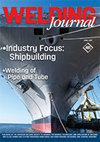Large-Scale Welding Process Simulation by GPU Parallelized Computing
IF 1.4
3区 材料科学
Q2 METALLURGY & METALLURGICAL ENGINEERING
引用次数: 8
Abstract
The computational design of industrially relevant welded structures is extremely time consuming due to coupled physics and high nonlinearity. Previously, most welding distortion and residual stress simulations have been limited to small coupons and reduced order (from three-dimensional [3D] to two-dimensional [2D]), or inherent strain approximations were used for large structures. In this current study, an explicit finite element code based on a graphics processing unit was utilized to perform 3D transient thermomechanical simulation of structural components during welding. Laser brazing of aluminum alloy panels as representative of automotive manufacturing scenarios was simulated to predict out-of-plane distortion under different clamping conditions. The predicted deformation pattern and magnitude were validated by laser scanning data of physical assemblies. In addition, the code was used to investigate residual stresses developed during multipass arc welding of a nuclear industry pressurizer surge nozzle and subsequent welding repair where a 3D simulation was necessary. Taking the experimental data as reference, the 3D model predicted better residual stress distribution than a typical 2D asymmetrical model. Stress evolution in welding repair was also presented and discussed in this study. The efficient numerical model made it feasible to use integrated computational welding engineering to simulate welding processes for large-scale structures.基于GPU并行计算的大规模焊接过程仿真
由于耦合物理和高度非线性,工业相关焊接结构的计算设计非常耗时。以前,大多数焊接变形和残余应力模拟仅限于小型试件和降阶(从三维[3D]到二维[2D]),或者对大型结构使用固有应变近似。在本研究中,使用基于图形处理单元的显式有限元代码对焊接过程中的结构部件进行三维瞬态热机械模拟。模拟了作为汽车制造场景代表的铝合金面板的激光钎焊,以预测不同夹紧条件下的平面外变形。通过物理组件的激光扫描数据验证了预测的变形模式和大小。此外,该代码还用于研究核工业稳压器稳压喷嘴的多道次电弧焊接过程中产生的残余应力,以及随后需要进行3D模拟的焊接修复。以实验数据为参考,三维模型比典型的二维非对称模型预测出更好的残余应力分布。本文还介绍并讨论了焊接修复过程中的应力演化。该高效的数值模型使采用集成计算焊接工程模拟大型结构焊接过程成为可能。
本文章由计算机程序翻译,如有差异,请以英文原文为准。
求助全文
约1分钟内获得全文
求助全文
来源期刊

Welding Journal
工程技术-冶金工程
CiteScore
3.00
自引率
0.00%
发文量
23
审稿时长
3 months
期刊介绍:
The Welding Journal has been published continually since 1922 — an unmatched link to all issues and advancements concerning metal fabrication and construction.
Each month the Welding Journal delivers news of the welding and metal fabricating industry. Stay informed on the latest products, trends, technology and events via in-depth articles, full-color photos and illustrations, and timely, cost-saving advice. Also featured are articles and supplements on related activities, such as testing and inspection, maintenance and repair, design, training, personal safety, and brazing and soldering.
 求助内容:
求助内容: 应助结果提醒方式:
应助结果提醒方式:


